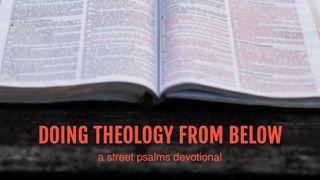8-Day Commentary Challenge - Romans 8Sample

THE INDWELLING SPIRIT AND THE NEW MORAL LIFE, 8:1–16
The Incarnation and Death of Jesus: The Divine Means to the Defeat of Sin in Human Life, 8:1–4
In verse 1 Paul states in summary and recapitulation, “Therefore, there is now no condemnation for those who are in Christ Jesus.” The “therefore now” probably goes back to 7:6 where, followed by a lengthy explanation of the holiness of the law and the sinfulness of human nature (7:7–25), Paul has stated that we are now free from the Mosaic Law’s dominion, which held us captive, and are able to serve God in the new life of the Spirit. There are also many parallels with the language of participation with Christ, as in 6:1–11.
To be “not under condemnation” (Gk. katakrima, 2:1[verb], 5:16, 18) presents some difficulties for the modern reader. The statement seems to ground escape from “condemnation” not in Christ’s work on the cross, but in the work of the Spirit in transforming sinners: “because [Gk. gar, “for”] through Christ Jesus the law of the Spirit who gives life has set you free from the law of sin and death” (v. 2). This seems to suggest that what Paul is saying is that sanctification (the righteous life of the believer) is the ground of our “no condemnation” in the sight of God. To get out of this seemingly unacceptable theological conclusion—for Reformation Christians at least!—several alternatives have been advanced.
(1) Many take the “no condemnation” as a summation of Paul’s argument in chapters 1–5 for justification (removal from judicial condemnation) by faith grounded in Christ’s own righteous act in His substitutionary death on the cross.
(2) Others believe that the “no condemnation” refers not to a judicial verdict but to the deliverance from the “penal servitude” of the law of sin and death. This view lacks linguistic support.
(3) Still others hold that “no condemnation” means justification as in view one above, but the grounds for this are seen to be not our holy lives but the justification effected toward us by Christ’s death. In other words the “fruit” of justification is sanctification.
But exegetically the text is better understood to argue that here Paul is stating that the ground or reason why we are not condemned is that we are now “in Christ Jesus.” Because of the indwelling power of the Spirit given to us when we were acquitted by faith in Christ’s death (5:5), we are delivered from the power of sin over our lives so that personal moral transformation now stamps our lives as indicative of our family relation to God (“sons,” “children” vv. 14 –16). As Paul looks ahead to the final judgment, his expectation of deliverance is grounded at least in three acts of God: substitutionary atonement in Christ (3:21, 26), personal transformation by the Spirit (6:1–14), and the ongoing intercession of Christ (8:34). Popular Protestantism has necessarily stressed the first of these essentials. Unhappily, this has led to an inadvertent and relative neglect of the second and third. Unfortunately, 8:1 has often been cited to justify this imbalance, when it really instead provides a much-needed corrective.
Finally, how does this interpretation relate to “works-righteousness,” a vital concern of the reformers? Calvin could say, “We indeed, allow that good works are required for righteousness; we only take away from them the power of conferring righteousness” (Commentaries on the Catholic Epistles, 317). A similar sentiment is expressed in the Westminster Confession: “Faith, thus receiving and resting on Christ and his righteousness, is the alone instrument of justification; yet is it not alone in the person justified, but is ever accompanied with all other saving graces, and is no dead faith, but worketh by love” (XI.2). Although we cannot be saved by good works, neither can we be saved without good works produced by the Holy Spirit in and through us.
Paul states again for us in verses 2–4 why there is no longer servitude to the sinful flesh. It is simply because Christians have been released from the former way of life “in the flesh” by the invasion of a new principle (law) of life lived in obedience to the Spirit (v. 3). How did this new manner of life come to us? It was made available totally through God’s own gracious, saving act in the coming and the death of His Son (vv. 3–4). Jesus entered into the world by fully identifying Himself with the sinful human flesh He came to redeem: “in the likeness of sinful flesh” (Gk. sarx, “flesh” v. 3). Yet it should be stressed first of all that “likeness” of sinful flesh means neither that Christ was sinful (see 2 Cor. 5:21; 1 Pet. 2:22), nor that He only appeared to be human, but that He came in real human flesh (He was fully human).
This real human flesh can be understood in two different senses. Some interpret the term “in the likeness of sinful flesh” to refer to the fact that Jesus came in real human flesh that “looked like” every other person since Adam (sinful flesh) but His humanity was different than ours because Christ, unlike the rest of us, did not have a sinful, or fallen, human nature. Thus in this view Paul uses the term “likeness” of fallen human nature (“sinful flesh”) to call attention to the difference between Jesus’ human nature and ours with respect to sinfulness. Others understand Paul to use the word “likeness” here as he does often elsewhere to mean not “looks like” but in the sense of “form of” or “reality of” without any suggestions of mere resemblance (cf. 1:23; 6:5; Phil. 2:7). This last sense is better and would mean that “the Son of God assumed the selfsame fallen human nature that is ours, but that in this case that fallen nature was never the whole of Him—He never ceased to be the eternal Son of God.” Another way to get at this difference is to ask whether Jesus would have eventually died of old age or disease if He had not been killed or executed. The former view says no; the latter says yes. The early Fathers of the church argued that only what Christ assumed in the incarnation is redeemable. Christ’s coming “for sin” means either that He came for a sin offering or that He came to deal with sin. The sin offering view is better supported.
Ultimately the purpose of His coming was to condemn “sin in the flesh” (v. 3). The law, by mere commanding, could not overcome the practice of sin in human nature. It could prescribe the will of God but provide no power for performing His will in face of our sinful flesh. Yet it was not the law’s fault that sin prevailed and even increased under its rule. The failure lay in the “weakness” of the law to effect righteousness in us because sin ruined our flesh, making it powerless to respond (7:7–25). But now God has done what the law wanted to do but could not do. He has condemned the rule of sin over human nature by creating a new humanity in Jesus Christ. By living a fully human life, totally in obedience to God, Jesus broke the rule that sin had held over human nature ever since Adam. He showed sin to be not natural to humanness but a usurper. By His own death, Christ provided the means where all who are related to Him can also enter into His same victory over the rule of sin (6:2–14).
The law of the Spirit of life in Christ Jesus (v. 2) is described in verse 4 as living not “according to the flesh but according to the Spirit.” In verses 5–14 Paul shows what is involved in this new way of living in the Spirit.
Scripture
About this Plan

This reading plan is from the Everyday Bible Commentary on Romans 8 and will help you dive deeper into Scripture. It is for anyone who has a desire to grow in their understanding of Scripture and strengthen your relationship with God by delving into this pivotal chapter of Romans.
More
We would like to thank Moody Publishers for providing this plan. For more information, please visit: https://www.moodypublishers.com/books/bible-study-and-reference/romans--everymans-bible-commentary/
Related Plans

Reading Galatians With Charles Spurgeon

HEBREWS AND I PETER Zúme Accountability Groups

ROMANS AND I TIMOTHY Zúme Accountability Groups

Doing Theology From Below

The Other Five Prayer Journey

Peace in the Storm

30 Days of Endurance for Women Leaders

What Happened to Us in Eden? - Psychology of the Fall

Retirement: It Always Ends in Death, So Let's Talk About It!
